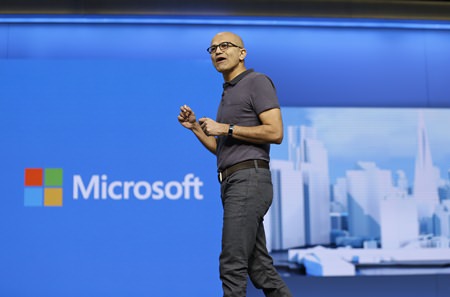San Francisco (AP) – Microsoft wants you to talk more with your computer — and have more useful conversations.
The giant software company is promoting new uses for Cortana — its voice-activated answer to Apple’s Siri digital assistant — including the ability to interact with software “bots” that can have limited conversations with users and help with tasks like booking a hotel room, ordering a meal or arranging a delivery.
Voice-activated services like Siri, “OK Google,” or Amazon’s Alexa can already perform tasks for users like playing a song at a request or answering a question. Bots are smarter than traditional software apps, though, using artificial intelligence to respond to a wider range of commands and in a convenient, conversational way.
 Microsoft CEO Satya Nadella delivers the keynote address at the Microsoft Build Conference, Wednesday, March 30, in San Francisco. (AP Photo/Eric Risberg)
Microsoft CEO Satya Nadella delivers the keynote address at the Microsoft Build Conference, Wednesday, March 30, in San Francisco. (AP Photo/Eric Risberg)
Microsoft CEO Satya Nadella, at the opening of the company’s annual conference for software developers last month, touted the power of “conversational intelligence” as he outlined a long-term vision in which Cortana, a central feature of Windows 10, becomes a digital concierge for other online interactions.
“Bots are the new apps,” Nadella told developers.
Lilian Rincon, a program manager for Microsoft’s Skype service, demonstrated how this might work. After receiving a video message from her boss that mentioned an upcoming conference in Dublin, Rincon used Cortana to mark the dates on her calendar. Cortana then used Skype to contact a hotel chain’s bot, which suggested a room and helped Rincon make a reservation for those dates.
Integrating Cortana with other companies’ bots could increase the use of Microsoft’s services, and make them more valuable, said analyst Ross MacMillan, who follows tech companies for RBC Capital Markets.
Bots are not perfect, however. Microsoft recently shut down an experimental Internet bot called “Tay” after some Twitter users taught it to make offensive statements.
Nadella acknowledged the episode, saying it shows the importance of designing technology to be “inclusive and respectful.”
Cortana isn’t as well-known as Siri or OK Google. But unlike those services, which are mostly found on smartphones and tablets, Microsoft has made Cortana available on desktop and laptop PCs, via Windows 10.
But Microsoft, after seeing its business suffer because fewer people buy new PCs, has also released Cortana as an app for smartphones and tablets that run Apple’s iOS or Google’s Android operating software. Similarly, Skype also works on those platforms.
Microsoft is now releasing programming tools for developers to build bots that will interact with Cortana. Not surprisingly, Microsoft would be glad to see people use these services on Skype, the Internet video and voice-calling service that it owns. But some of its tools for creating bots will work with other messaging services: Microsoft listed Slack and standard text messaging, among others.
Microsoft Corp. has also announced a free upgrade this summer to Windows 10 that adds some new features and expands others. The company has touted Windows 10 as the operating system for a wide range of devices, from personal computers to hand-held gadgets, Xbox game consoles and even the company’s HoloLens augmented-reality headset.
Microsoft says Windows 10 is now running on 270 million devices, up from 200 million in January. Analysts say that’s a respectable figure, considering it was released last July, although Microsoft is aiming for 1 billion devices in a few years.
The Windows 10 upgrade will include expanded abilities for Cortana, which will be able to provide reminders or answer questions even if it’s on a device, such as a tablet or smartphone, where the user hasn’t unlocked the screen.
Another new feature will extend Microsoft’s biometric software, Windows Hello, so users can log into more apps and online accounts through fingerprint or facial recognition. The upgrade also expands the ways in which uses can write their own notes or draw lines and sketches with a digital pen on websites, maps and other images that are displayed on their screens.




